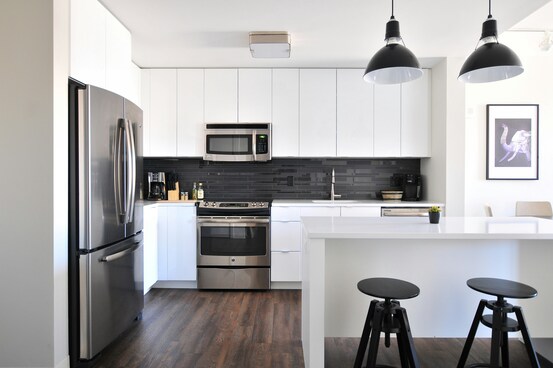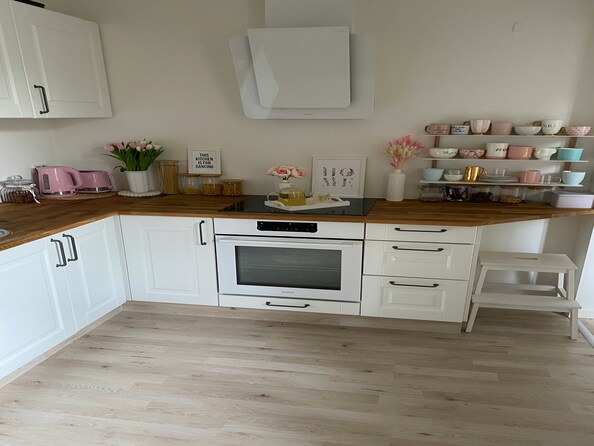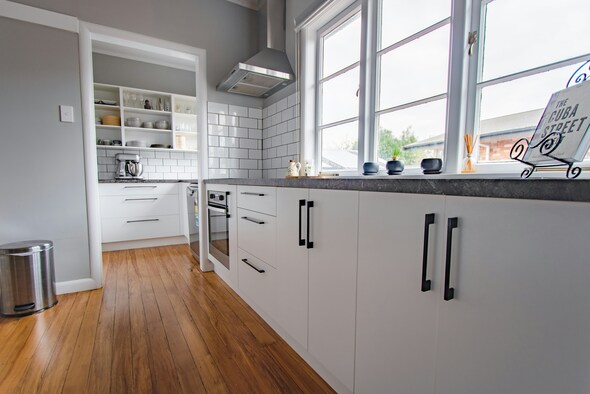Transform Your Kitchen with These Trendy Flooring Materials
Choosing the perfect flooring for your kitchen can be a daunting task. Not only does it need to look great, but it also has to stand up to the daily wear and tear of a busy household. With so many options available, where do you even begin? Don’t worry—we’ve got you covered. In this post, we’ll explore five stylish and durable flooring materials that could be the perfect fit for your kitchen. Let’s get started!
The Role of Kitchen Flooring
 When it comes to kitchens, flooring is more than just something to walk on. It sets the tone for the entire room, creating a backdrop that can either enhance or detract from your overall design. From rustic farmhouse charm to sleek modern aesthetics, the right flooring can drastically change the look and feel of your space.
When it comes to kitchens, flooring is more than just something to walk on. It sets the tone for the entire room, creating a backdrop that can either enhance or detract from your overall design. From rustic farmhouse charm to sleek modern aesthetics, the right flooring can drastically change the look and feel of your space.
The kitchen flooring also needs to be functional. It should be able to withstand spills, stains, and the occasional dropped pot or pan. Plus, it should be comfortable underfoot, especially if you spend a lot of time cooking or entertaining.
Next, we’ll take a closer look at five popular kitchen flooring materials and discuss their unique features, benefits, and drawbacks.
Top 5 Flooring Materials
Hardwood
Timeless Elegance
Hardwood flooring is a classic choice that never goes out of style. With its warm tones and natural beauty, hardwood can add a touch of elegance and sophistication to any kitchen. Available in a variety of wood species, finishes, and plank sizes, it’s easy to find a hardwood floor that complements your design aesthetic.
Durability and Longevity
One of the main advantages of hardwood is its durability. When properly maintained, hardwood floors can last for decades, making them a worthwhile investment. Plus, they can be refinished multiple times to remove scratches and restore their original beauty.
Maintenance and Care
While hardwood is relatively low-maintenance, it does require regular care to keep it looking its best. Spills should be cleaned up promptly to prevent staining, and it’s important to use a hardwood-safe cleaner to avoid damaging the finish.
Tile (Ceramic, Porcelain, and Natural Stone)
Versatility and Style
Tile flooring is another popular choice for kitchens, thanks to its versatility and wide range of styles. Ceramic and porcelain tiles come in an array of colors, patterns, and textures, allowing you to create a custom look that suits your taste. Natural stone tiles, such as marble, granite, and slate, offer a luxurious and timeless appeal.
 Durability and Water Resistance
Durability and Water Resistance
Tiles are highly durable and water-resistant, making them an excellent option for kitchens. They’re also resistant to stains and scratches, which is ideal for high-traffic areas. Porcelain tiles, in particular, are known for their strength and long-lasting performance.
Maintenance and Grout
While tiles themselves are easy to clean, grout lines can be a bit more challenging. Regular scrubbing and sealing can help keep grout looking fresh and prevent discoloration. Additionally, it’s important to choose a slip-resistant tile for safety in a kitchen environment.
Laminate
Cost-Effective and Stylish
Laminate flooring is a budget-friendly alternative to hardwood and tile, offering a similar look at a fraction of the cost. Modern laminate floors come in a variety of designs that mimic the appearance of natural wood or stone, providing a stylish and affordable option for homeowners.
Easy Installation
Laminate is known for its easy installation process, which can often be done as a DIY project. The planks simply click together, creating a floating floor that doesn’t require nails or glue. This makes it an attractive option for those looking to save on installation costs.
Maintenance and Durability
While laminate is relatively durable, it’s not as water-resistant as other options. Spills should be cleaned up quickly to avoid damage, and it’s important to use a damp mop rather than a wet one. Laminate floors can also be prone to scratching, so it’s a good idea to use furniture pads and area rugs in high-traffic areas.
Vinyl
Versatile and Resilient
Vinyl flooring has come a long way in recent years, offering a versatile and resilient option for kitchens. Available in sheets, tiles, and planks, vinyl can mimic the look of wood, tile, or stone, providing a stylish and practical solution for homeowners.
Water and Stain-resistant
One of the main advantages of vinyl is its water and stain resistance. This makes it an ideal choice for kitchens, where spills and splashes are common. Vinyl is also comfortable underfoot and provides a bit of cushion, which can be a relief for those who spend a lot of time standing in the kitchen.
Easy Maintenance
Vinyl floors are low-maintenance and easy to clean. Regular sweeping and occasional mopping with a vinyl-safe cleaner will keep them looking their best. Plus, vinyl is more forgiving than other materials, making it a great option for families with kids and pets.
Concrete
Modern and Industrial
Concrete flooring has gained popularity in recent years, especially in modern and industrial-style kitchens. Its sleek, minimalist look can create a striking contrast with other materials and add a touch of contemporary sophistication to your space.
Durability and Customization
Concrete is incredibly durable and can withstand heavy foot traffic, making it an excellent choice for busy kitchens. It’s also highly customizable, with options for staining, polishing, and even embedding decorative elements like tiles or glass.
Maintenance and Comfort
While concrete is low-maintenance, it does require sealing to prevent staining and moisture absorption. Additionally, it can be hard and cold underfoot, so it’s a good idea to use area rugs or mats in areas where you spend a lot of time standing.
 Factors to Consider When Choosing
Factors to Consider When Choosing
Lifestyle
Your lifestyle plays a significant role in determining the best flooring material for your kitchen. If you have a busy household with kids and pets, you’ll need a durable and easy-to-clean option like tile or vinyl. If you love to cook and spend a lot of time standing in the kitchen, you might prefer a more comfortable option like vinyl or laminate.
Budget
Budget is another crucial factor when selecting kitchen flooring. While some materials like hardwood and natural stone can be expensive, there are more affordable options like laminate and vinyl that can still provide a stylish and functional solution. It’s essential to weigh the initial cost against the long-term value and maintenance requirements.
Maintenance
Consider the level of maintenance you’re willing to commit to when choosing your kitchen flooring. Some materials, like hardwood and tile, require regular care and upkeep, while others, like vinyl and laminate, are more low-maintenance. Be sure to choose a material that fits your lifestyle and cleaning preferences.
Selecting the right flooring material for your kitchen is a crucial decision that impacts both the aesthetics and functionality of your space. By considering factors like lifestyle, budget, and maintenance, you can find the perfect option to suit your needs.
Have you recently updated your kitchen flooring? Share your experiences and tips in the comments below. If you have any questions or need further advice, don’t hesitate to reach out. We’re here to help!
Book a consultation with one of our experts today and start transforming your kitchen with the perfect flooring material.


 Durability and Water Resistance
Durability and Water Resistance Factors to Consider When Choosing
Factors to Consider When Choosing

